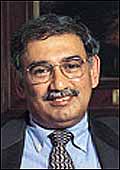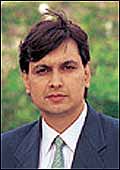|
It
was perhaps the fear that it would go down in history as a Joint
Parliamentary Committee that didn't finish its work-the committee
has to, perforce, go out with the 13th Lok Sabha-that prompted the
JPC, the fourth ever constituted in Indian history, to scramble
and publish its report on the fertilisers-in-soft-drinks controversy.
Not that the JPC, headed by Nationalist Congress Party Chief Sharad
Pawar, said anything new. One on count, the most important one,
it agreed with the Centre of Science and Environment's (CSE) findings
that most soft drinks sold in the country (including those manufactured
by Coca-Cola and Pepsi) had residues of pesticides. On another,
it differed: the organochlorine and organophosphorous pesticides
weren't present in excessive quantities as reported by CSE. That
was salve enough for the conscience of the two companies mentioned
above. Coca-Cola's Sanjiv Gupta, says, "The statement we have
released has said what we have to say on the matter and there is
really nothing more I can say. We have been following the norms
laid out by the health ministry, and all the water we use in our
products is now treated even more rigorously than before."
And a Pepsi release says, "We have always produced beverages
in India that are absolutely safe and made according to the same
high quality standards we use around the world."
The report recognises the need for food-safety regulation in India
and appreciates the work of CSE; the organisation's chief Sunita
Narain promises to ''ensure that this report does not get shelved...
and that every Indian gets safe food''.
P.S.: The JPC in the slug is easy; OPC stands
for organophosphorous cola.
-Kushan Mitra
Ranbaxy
Vs DRL
A match report on the first Pharma Cup, dated
February 7.
 |
| Ranbaxy's Malvinder Singh: Getting his
team home |
India-Pakistan this was
not, but the game had it all. Towering sixes, dropped catches, injured
players, and a nail-biting finish. No we haven't become Sports Today
yet. We are talking about the first ever edition of the Pharma Cup
featuring Ranbaxy and Dr. Reddy's Laboratories (DRL). Cheering them
on were executives from both, including D.S. Brar, CEO, Ranbaxy,
Brian Tempest, CEO-designate, Ranbaxy and Satish Reddy, Managing
Director, DRL. Malvinder Singh, President (Pharma), Ranbaxy, decided
that things were better done in the middle, and donned the whites.
Even though the mild winter sun made this usually sleepy correspondent
even more so, the supporters were charged up, cheering their mates
on. Brar wondered why some of the smaller pharma companies were
not there. Reddy agreed, and plans to invite some teams when DRL
hosts the event next year. "Even if we lose, we might be able to
gain on the headhunting side (wink-wink)", a senior official was
caught mentioning. By the way, Ranbaxy won by three wickets scoring
the requisite 206 runs with three balls to spare.
-Kushan Mitra
BAD NEWS
Grounding Hopes
 »
The Cabinet shoots down a proposal allowing private
carriers to fly to Europe and the US. »
The Cabinet shoots down a proposal allowing private
carriers to fly to Europe and the US.
»
India's premier tech companies are accused by
US labour agencies of flouting visa rules.
»
Ninety-eight per cent of public sector companies
report losses of Rs 81,015 crore in 2003-04, the highest ever.
»
Public sector bank, Canara Bank classifies its
Rs 390-crore loan to Dabhol Power Company a bad loan.
STREET
WISE
A Bigger Picture
The Indian entertainment industry has to look
beyond films and television.
The Indian entertainment industry, as
the Federation of Indian Chambers of Commerce and Industry (FICCI)
helpfully points out, is worth all of Rs 16,600 crore, and should
grow at 20 per cent annually to hit Rs 41,900 crore by 2007. I am
not sure what's more impressive: The exactness of these figures,
or what FICCI, via its annual convention on the "Business of
Entertainment"-called frames-has achieved over the past three
years. Now many of us sceptical folk look at such shindigs as, at
best, great networking opportunities, but film maker Yash Chopra,
and Sony Entertainment Network CEO Kunal Dasgupta, Chairman and
Co-Chairman of the FICCI Entertainment Committee, respectively,
will convince you that the three frames conventions haven't been
just fun and games (and that frames 2004-to be held between March
15 and 17-indeed won't be just another cosy jamboree for film and
television folk).
To be sure, if the film industry is today recognised
as an industry-making it eligible for bank and institutional financing-it's
thanks to the efforts of FICCI and frames. "Earlier, the film
industry didn't have a lobby to approach the government," explains
Chopra. Now, thanks to the industry status, IDBI has condescended
to lend some Rs 100 crore to film makers. Not just that some 100
films have so far been insured, including Chopra's six.
Impressive? I am not so sure because fact is
that most bankers still look at film financing as too high-risk.
They're right: Film-making is fraught with failure, what with just
one out of 10 films being destined to make money. The industry for
its part feels that bankers have to change their mindsets-"talented
people have to be backed, banks need to have the requisite human
capital to be able to unbundle risk," is the refrain-but if
the chances of a film being a hit are just 10 per cent, you need
to woo a very brave banker to back a movie maker.
The problem actually is not so much bankers'
reluctance to fund the entertainment sector, but rather the industry's
inability to throw up genuine financing opportunities, besides films
and television. To its credit, the FICCI Entertainment Committee
has realised the industry needs to open up alternative streams of
revenue (besides television, music, and radio), and build broad-based
entertainment conglomerates, with a finger in several pies, mitigating
the risk associated with any particular segment (specially film
making). The options are indeed many, and several, ranging from
animation to pc gaming to digital cinema to in-film placement and
movie merchandising-all of which are happening in bits and pieces-will
be the focus of frames 2004. Consider animation: If India's it industry
has been able to develop a world-class competitive advantage, what's
stopping Indian studios from tying up with global animation companies
for outsourcing and co-production.
Or take the pc gaming industry, which boasts
such big names as Nintendo, Playstation, Sega, and Gameboy, and
which is a $28-billion industry globally, apparently now eating
into Hollywood territory. As Sony's Dasgupta points out, one game
can bring in as much as $500-$600 million in distribution. Why can't
India's software developers get into this, well, game!
If FICCI and frames are able to get Andy Bird,
President, Walt Disney International, to explore alliances with
Indian animation companies Crest and Jadoo Works, or Electronic
Arts (a global leader in interactive gaming) to source games from
perhaps a Dhruva Interactive (a promising Indian game developer),
frames 2004, would have more than done its bit.
-Brian Carvalho
FORECAST
Will We Sell A Million Cars?
 Jagdish
Khattar Jagdish
Khattar
Managing Director, MUL
No
If we can cross a million vehicles, it would a dream, and a very
nice one at that. Frankly, I do not expect the stellar growth of
last year to carry on. I believe that that the 'A' and 'B' segments
(small cars) will continue to be the major growth drivers.
 B.V.R.
Subbu B.V.R.
Subbu
President, Hyundai Motor India
No, but only just
I expect the passenger vehicle market to fall just a bit short of
the million unit mark. In 2003, we sold just over 800,000 vehicles,
but I do believe that passenger cars alone will account for about
800,000-plus units in 2004. In terms of trends, I think that this
year will see three major trends emerging: consumer focus on safety
technology, an increased awareness of design in car purchases and
the continuing boom in the 'C' (small sedan) segment.
 Rajiv
Dube Rajiv
Dube
VP, Passenger Car Division, Tata Motors
Maybe
The year has started on a positive note, but I think last year's
growth will be difficult to sustain. However, if the economy carries
on the way it has, growth should be very good.
-Kushan MitraAshish Gupta
|
